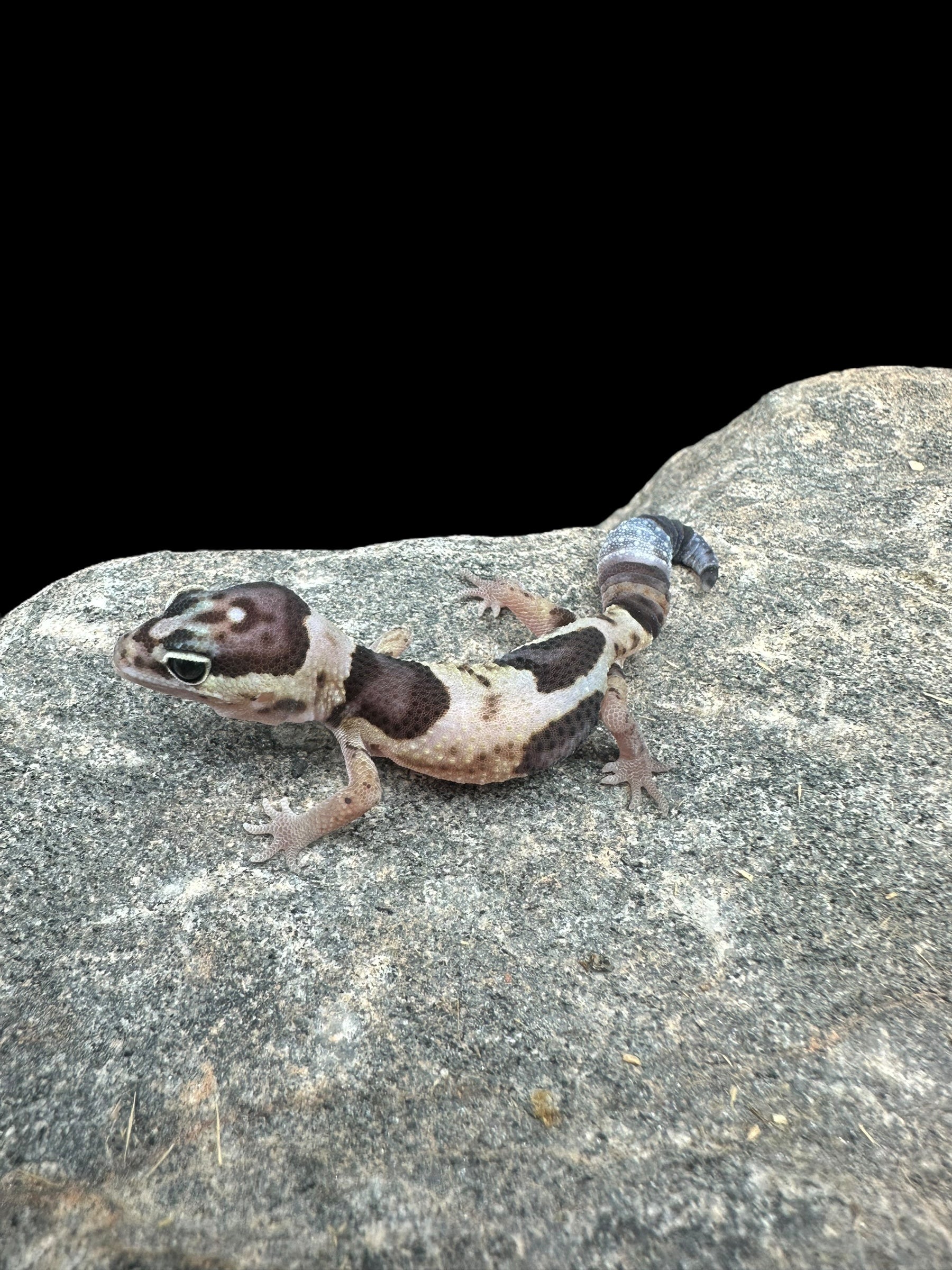Photo Disclaimer
Description
African Fat Tail Gecko (White Out poss. het. Amel Ghost)
Scientific Name: Hemitheconyx caudicinctus
Common Name: African Fat Tail Gecko
Species Overview
Size: Adult African Fat Tail Geckos typically reach 7–8 inches (18–20 cm) in length, with males being slightly larger and more heavily built. Their thick tails function as vital nutrient stores, supporting hydration and energy balance.
Appearance: The White Out poss. het. Amel Ghost African Fat Tail Gecko showcases the bold and unpredictable visual impact of the White Out gene. This morph features irregular marbling and contrast, with pattern variations ranging from deep browns and greys to cream and light tan. The potential presence of the Amel (Albino) and Ghost genes adds breeding value—Amel removes dark pigmentation when expressed, while Ghost softens melanin for cooler, desaturated tones. Although neither is visually active in this gecko, both may influence its undertones slightly, giving some individuals a lighter, more muted look.
Distribution: Native to West Africa, including Senegal, Ghana, Togo, Benin, and Nigeria, where they inhabit dry savannas, scrublands, and rocky grasslands.
Habitat: In their native environment, these geckos dwell in burrows or beneath stones during the day to retain moisture and avoid the heat. In captivity, they thrive in naturalistic terrariums that replicate these semi-arid habitats, using compacted soil-sand substrates, moderate humidity, and multiple hides for comfort and security.
Behaviour: African Fat Tail Geckos are calm, nocturnal, and patient. The White Out morph retains the species’ steady, predictable temperament, making it well-suited for both display and advanced breeding projects.
Captive Care
Enclosure: Provide a minimum enclosure size of 24 inches × 18 inches × 12 inches (60 × 45 × 30 cm) for a single adult. Naturalistic setups with compact soil-sand-clay blends are recommended to promote burrowing and natural behaviour. For juveniles or during quarantine, reptile carpet, tile, or paper towel can be used for safety and ease of maintenance. Include at least three hides—one on the warm side, one on the cool side, and one humid hide to assist with shedding.
Temperature & Humidity: Maintain a warm-side surface temperature between 88–92°F (31–33°C) and a cool side around 75–80°F (24–27°C). Nighttime temperatures can safely drop to 70–74°F (21–23°C). Keep humidity between 50–70%, ensuring a moist hide is always available to aid in shedding.
Lighting: Although UVB lighting is not essential, low-output UVB (2–5%) supports natural activity, proper calcium absorption, and healthy behaviour. Maintain a consistent 12-hour day/night light cycle.
Diet: Feed a variety of gut-loaded crickets, dubia roaches, mealworms, and silkworms. Dust feeders with calcium and multivitamins on a regular schedule. Juveniles should be fed daily, while adults can be fed every 2–3 days.
Behaviour in Captivity: These geckos are calm and highly adaptable, responding well to routine care. They rarely display defensive behaviour and are tolerant of handling once accustomed to consistent care.
Special Considerations: Always use a thermostat to regulate heat sources and prevent burns. Monitor tail thickness and body weight regularly as indicators of health.
Sand: Addressing Concerns and Misconceptions
Sand has long been debated as a substrate due to potential impaction risks. When used properly—as part of a compacted soil-sand mixture and paired with correct heating and hydration—it poses minimal concern. Issues arise mainly from loose or calcium-based sands combined with poor husbandry. For young, stressed, or newly acquired animals, reptile carpet, tile, or paper towel are recommended until they are fully established.
Taxonomy Note
The African Fat Tail Gecko (Hemitheconyx caudicinctus) belongs to the family Eublepharidae, which includes eyelid geckos such as the Leopard Gecko (Eublepharis macularius). These geckos possess functional eyelids and lack adhesive toe pads, making them completely terrestrial. The species is taxonomically stable, with minor colour variation across its West African range.
Genetics Note
White Out (Incomplete Dominant): Modifies the natural pattern and coloration, producing unpredictable, high-contrast marbling and pattern disruption. When bred in pairs, two White Outs can produce “Super White Outs,” which display lighter and more pattern-reduced appearances.
poss. het. Amel (Possible Recessive Carrier): May carry one copy of the Amel (Albino) gene, which eliminates dark pigment when expressed. Confirming this gene requires test breeding with a known Albino or het. Albino partner.
poss. het. Ghost (Possible Recessive Carrier): May carry one copy of the Ghost gene, which reduces melanin to produce cooler, faded tones and a soft, pastel-like appearance. As with Amel, test breeding is required to verify expression.
(“het.” is short for heterozygous, meaning one copy of a gene is carried but not visually expressed.)

